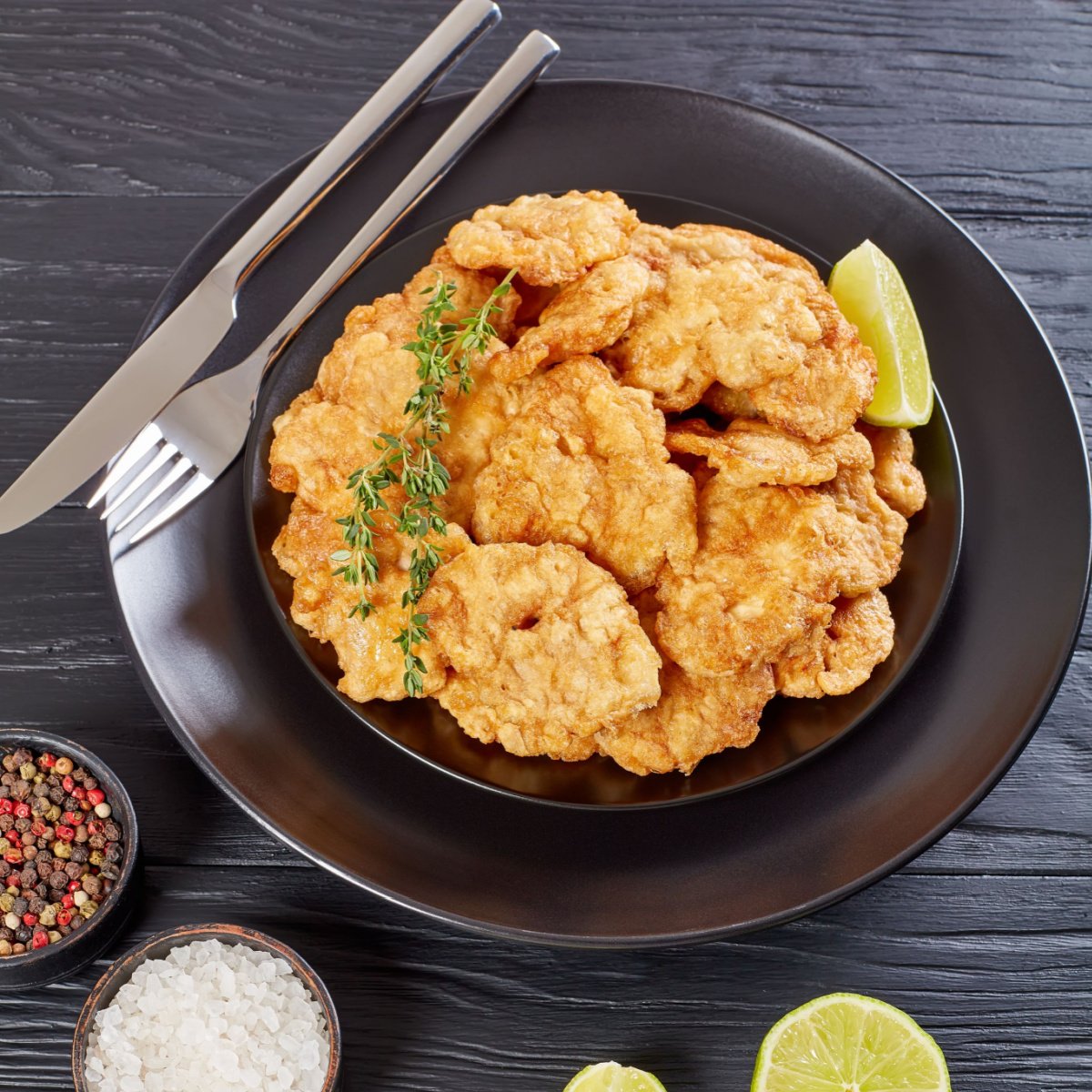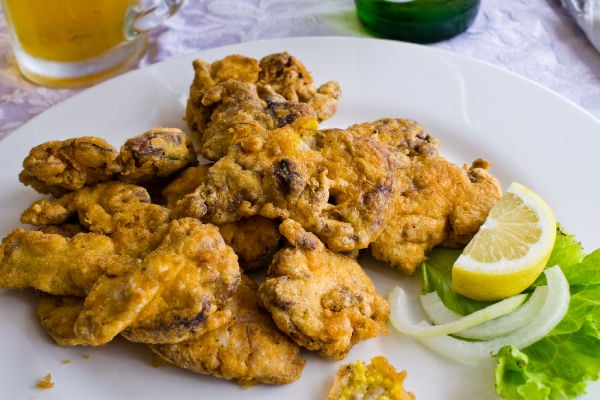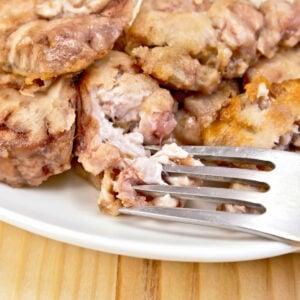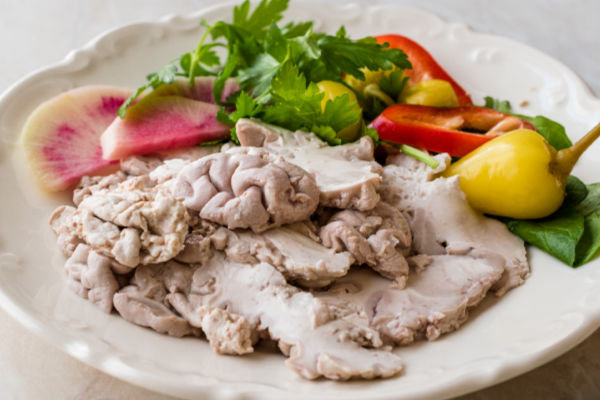Zombies aren’t the only ones that appreciate a serve of brain for dinner. In some cultures, they’re considered a delicacy and they often pop up in restaurants around the world. If you’re the type of person that enjoys tasting new foods then you may be wondering what do brains taste like? This article will look at the flavor and texture of brains from different animals, a suggested recipe, and more. Sorry, no human brains were taste tested during this research.

Table of Contents
What does a brain taste like?
Although the flavor will vary depending on the animal, brains generally have a savory taste with a bitter undertone. Brains don’t compare to any other part of the animal in flavor. The iron-like taste that comes from liver or the gamey, umami-packed hit that you get from kidneys doesn’t exist in the brain. At a pinch, the closest internal organ it compares to is sweetbread, aka the thymus or pancreas.
The texture of a brain is firm yet tender and creamy. It tends to hold its shape well until bitten into, after which it turns into a mushy paste-like consistency. The closest food we could compare it to based on texture would be tofu, ackee or scrambled eggs.
Perhaps the biggest obstacle to overcome when trying your first animal brain is the appearance. They bear a striking resemblance to the human brain, only smaller. If you’re at a restaurant, you may want them to be cooked in a batter to disguise the lobes, which don’t look that appealing.

Do different animal brains have different flavors?
All brains tend to have a similar flavor and texture, although there is usually a subtle hint of the animal’s taste in the brain too.
Lamb's brain is one of the most popular choices for eating and its consistency is gelatinous. Some people believe it has a sashimi-like taste, with a texture that offers no resistance once bitten into.
Pig’s brain is another popular option with a mouthfeel that is very similar to that of lamb’s brain. It isn’t an overpowering food, and you’ll detect a creamy, umami flavor with a subtle undertone of pork. The brain of a pig is often used in Chinese cuisine, cooked in multiple different styles.
Chicken brains are a lot smaller than most other options you’ll get the opportunity to eat. To give you an idea, each one is smaller than the bird’s eyeball, so you’ll need a lot to provide a decent-sized meal. They’re fatty organs that taste a lot like chicken fat and have a unique sponge-like texture.
Goat brain is similar in texture to a lamb’s brain. However, its taste is often a little bland, so if you avoid strong-tasting foods, then this could be the option for you.
Cow brains are also quite bland, with a faint taste of beef. However, the consumption of this offal is restricted in some parts of the world. Although the chances are slim, it is possible to contract bovine spongiform encephalopathy, which is better known as mad cow disease.
How to Buy Brains

The easiest option is to visit a restaurant that serves this menu item. If you prefer to cook them at home, then visit your local butcher. You’re often able to buy them in packs, frozen for convenience.
For a more primitive approach, you can also buy the head of a beast and crack open the skull at home to reveal the meaty treat inside. But this isn’t a five-minute task unless you have some serious butchery equipment. You may prefer to ask your butcher to process the head for you. Other options for sourcing brains include visiting a local farm or even a halal meatmarket.
Tip: If you like trying new foods, then check out our articles on eating kangaroo, the Scottish classic haggis which uses offal, balut, or, for a crunchy snack, scorpion.
Recipe

How to Cook a Brain
Ingredients
- 8 brains of your choice
- 1 ½ tsp kosher salt
- 8 parsley stalks
- ½ cup flour
- 2 eggs lightly beaten
- 1 ½ cups breadcrumbs
- 1 Tbsp vegetable oil
Instructions
- Remove as much filament as possible without damaging the structure of the brains, then gently place them in a pot of cold water. Add the salt and parsley and heat on medium-high until the water begins to boil. Reduce the temperature and allow to gently simmer for five minutes. Use a pair of tongs to carefully transfer the brains to a plate and pat them dry.
- Use your fingers to separate the two lobes and remove any unwanted filament. For larger animals like a cow or a pig, there will be more to trim.
- Coat the brains in flour, dunk each one into the beaten egg, then coat the brains in breadcrumbs.
- Heat the oil in a skillet until hot, then add the brains and briefly fry each side for one minute. Transfer the brains to a plate and serve immediately with roast vegetables, horseradish mayonnaise, and lemon wedges.
Nutrition
What countries enjoy eating them?
Chinese love adding brains in the Sichuan region, barbecued or added to a flavorsome hotpot. Tianma Zhunao Tang is a more popular dish in southern China; the brain of a pig is an essential ingredient in this meal.
Brain fritters are a much-revered dish in Cuba. They coat the organs in bread crumbs before frying until golden brown.
Cow’s brain is a much-loved ingredient in Indonesia. A classic dish cooked by the Minangkabau people. They add them to a curry (gulai banak) which includes a delicious gravy made from coconut milk.
French cuisine uses brains in tête de veau, which involves boiling an entire calf’s head for many hours until tender. This dish is also popular in other parts of Europe, such as Italy, Germany, and Belgium.
Muslim cuisine enjoys a recipe called maghaz. It originated from the Indian subcontinent and involves serving a goat's, sheep's, or cow’s brain with gravy. Turkey has a dish called beyin sogus, which uses the offal of a lamb, including the brain.

Nutrition Breakdown
Brains are high in omega-3 fatty acids, antioxidants, and other nutrients like phosphatidylserine and phosphatidylcholine. They’re also high in potassium and vitamin B12 while being low in saturated fat and calories. However, they should be eaten in moderation if you’re watching your cholesterol.
Nutrition Facts: Lamb Brain (4 ounces)
| Calories | 130 |
| Total Fat | 9.7g |
| Saturated fat | 2.5g |
| Cholesterol | 1528mg |
| Carbohydrates | 0g |
| Sugar | 0g |
| Protein | 11.8g |
Final Words
Older generations commonly grew up eating brains for dinner, often cooked with bacon. Although not as popular as they used to be, there are still restaurants that put them on the menu. Maybe you want to give them a try?
If you do eat them, you’ll find they have a unique savory taste, somewhat like sweetbread. However, it is not the flavor that tests a brain novice. Appearance is usually the stumbling block. The brain is made up of 60% fat and held together by veins and blood vessels. It’s not the most appealing organ to look at, even once cooked. If you can overcome its aesthetics, you are likely to enjoy this food. It doesn’t have any off-putting, funky flavors to catch you out. We’d recommend giving it a try at least once; you may enjoy it as previous generations did.
For more interesting reading, be sure to read our article on the taste of fugu. Is it worth the money? Find out now.
What is your favorite offal to eat? Kidney, liver, or something else? Please let us know in the comments below.

Leave a Reply